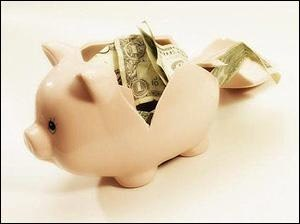By Pam Martens and Russ Martens: August 28, 2020 ~
 Thanks to the behemoth banks on Wall Street that engineered the largest Inside Job in the history of global banking and cratered the economy in 2008, retirees are now looking at a yield of 0.75 percent on a 10-year U.S. Treasury note. That paltry yield compares to the 4 percent or higher that retirees have been able to get throughout much of the last century on a T-Note.
Thanks to the behemoth banks on Wall Street that engineered the largest Inside Job in the history of global banking and cratered the economy in 2008, retirees are now looking at a yield of 0.75 percent on a 10-year U.S. Treasury note. That paltry yield compares to the 4 percent or higher that retirees have been able to get throughout much of the last century on a T-Note.
The Federal Reserve is directly responsible for these unprecedented low yields. For much of the past 12 years, the Fed has been manipulating interest rates lower by buying up trillions of dollars in bonds (quantitative easing) in order to avoid crashing the Wall Street banks. The Wall Street banks are holding tens of trillions of dollars in interest-rate derivative bets — betting that rates won’t rise substantially or will drift lower. So the Fed has to make sure that’s what happens even if struggling Americans have to choose between paying rent or going hungry.
Consider the math. Let’s say you are a widow living on Social Security and a small pension. Let’s say you had a nest egg before the Wall Street crash in 2008 of $150,000 on which you earned 4 percent ($6,000 a year) from a T-Note. But you’ve had to dip into that principal over the past decade to make ends meet. You have just $125,000 left and the 4 percent T-Note has matured. If you roll that over at 0.75 percent, the going rate on a 10-year T-Note, your supplemental income shrinks from the pre-crisis $6,000 to a post-crisis $937.50.
That’s the kind of income squeeze tens of millions of retired senior citizens in America are facing, thanks to the Federal Reserve’s cozy ties to Wall Street.
Now seniors have another financial worry. Cash dividends on stocks are being suspended or cut at a rate not seen since the last financial crisis.
Here’s a sample of some of the cuts: Apache Corp. slashed its quarterly dividend by 90 percent. Harley-Davidson cuts its dividend from 38 cents to 2 pennies – a decline of 95 percent. Occidental Petroleum reduced its dividend by 86 percent. Royal Dutch Shell cut by 66 percent. The oil field services company, Schlumberger, cut its dividend by 75 percent while the San Francisco-based bank, Wells Fargo, slashed its quarterly payout by 80 percent to 10 cents a share.
Now consider the big corporate names on the following list that have suspended their dividend in its entirety — for how long it’s very hard to predict. This list of 55 companies is by no means an exhaustive list. It’s simply the names we could verify digging through corporate press releases.
A sampling of companies that have announced dividend suspensions in 2020:
Alaska Air Group
AMC Entertainment Holdings
American Airlines
Aptiv
ArcelorMittal
Arch Coal
Bed Bath & Beyond
Boeing
Brinker International
Carnival
Cato
Cheesecake Factory
Choice Hotels
Columbia Sportswear
Continental Resources
Coty
Dave & Buster’s Entertainment
Delta Airlines
Dine Brands Global (Operator of IHOP and Applebee’s)
Disney
Dunkin’ Brands Group
Estée Lauder
Expedia Group
Ford
General Motors
Gildan Activewear
Goodyear Tire
Group 1 Automotive
HCA Healthcare
Hilton
HSBC
Kelly Services
Kimco Realty
Las Vegas Sands
MTS Systems
Macy’s
Marathon Oil
Marriott
Meredith Corp.
Molson Coors
National Oilwell Varco
Nordstrom
Park Hotels & Resorts
Plantronics
Ralph Lauren
Ross Stores
Royal Caribbean Cruises
Southwest Airlines
Standard Motor Products
TJX Companies
Terex
Westpac Banking
Weyerhaeuser
Western Digital
Wynn Resorts
In addition to hurting retirees’ sources of income in the short term, the cuts and suspension of dividends could deliver long-term pain to the total returns that all investors are expecting from the stock market. Total return represents the combination of growth in the share price combined with the reinvestment of cash dividends.
Most investors do not realize that cash dividends on stocks represent, in real terms (after inflation), approximately 75 percent of their long-term total return.
The late John Bogle wrote about that fact in his book: Don’t Count on It!: Reflections on Investment Illusions, Capitalism, “Mutual” Funds, Indexing, Entrepreneurship, Idealism, and Heroes. Bogle was the founder of the low-cost mutual fund company, Vanguard Group. Bogle wrote this:
“Theory tells us, and experience confirms, that dividend yields play a crucial role in shaping stock market returns. In fact, the dividend yield on stocks has accounted for almost one-half of their total long-term return…
“When we take inflation into account, the importance of dividend income is magnified even further. During the past century, the average rate of inflation was 3.3 percent per year reducing the nominal 5 percent earnings growth rate to a real growth rate of just 1.7 percent. Thus, the inflation-adjusted return on stocks was not 9.6 percent, but 6.3 percent. In real terms, then, dividend income has accounted for almost 75 percent of the annual investment return on stocks.”

